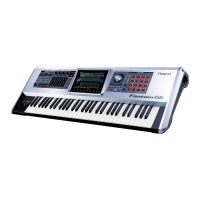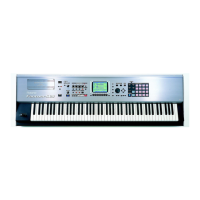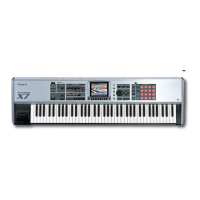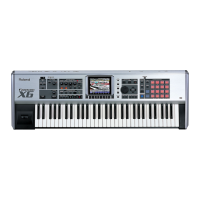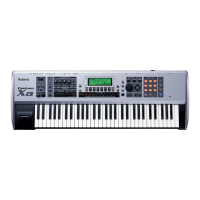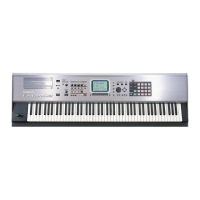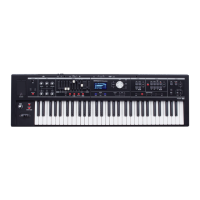297
System Settings (Settings Common to All Modes)
Overview Sound 1 Sound 2 Sound 3 Pad Sampler
Menu/System
AppendixSequencer
Metronome Mode
Specifies when you want the metronome to sound.
* If [F7 (Click)] in the Tempo window which appears when you press
[TEMPO] is lit in red, the metronome will always sound.
Value
OFF:
Will not sound.
PLAY-ONLY:
Will sound only during playback.
REC-ONLY:
Metronome will sound only for recording.
PLAY&REC:
Metronome will sound for playback and recording.
ALWAYS:
Metronome will always sound.
Metronome Level
You can adjust the volume of the metronome.
Value:
0–10
Metronome Sound
Selects the metronome sound.
Value
TYPE 1:
A conventional metronome sound will be heard. A
bell will sound on the first beat.
TYPE 2:
Clicks will sound.
TYPE 3:
Beeps will sound.
TYPE 4:
Cowbell will sound.
Beat Indicator Mode
You can specify how the [PLAY] button (beat indicator) on the panel
will blink.
Value
ALWAYS:
Always blinks at the specified tempo.
PLAY&REC:
Blinks only during playback and recording.
Local Switch
The Local Switch determines whether the internal sound generator is
disconnected (OFF) from the controller section (keyboard, pad, pitch
bend/modulation lever, knobs, buttons, D Beam controller, pedal,
and so on); or not disconnected (ON). Normally this is left “ON,” but
if you wish to use the Fantom-G’s keyboard and controllers to
control only external sound modules, set it to “OFF.”
Value:
OFF, ON
Master Tune
Adjusts the overall tuning of the Fantom-G. The display shows the
frequency of the A4 note (center A).
Value:
415.3–466.2 Hz
Master Level
Adjusts the volume of the entire Fantom-G.
Value:
0–127
Master Reverb Level
Adjusts the reverb level of the entire Fantom-G.
Value:
0–127
Metronome
Sound
Using the Local Switch
If you’re using external sequencer software in conjunction with
the Fantom-G’s keyboard/controllers and sound generator, you
should turn the Local switch OFF for the reasons explained
below.
Connecting the Fantom-G to an external
sequencer
fig.25-003b_50
Typically, things are hooked up so the data travels as follows:
the Fantom-G’s keyboard → your external sequencer software
→ the Fantom-G’s sound generator. Normally, the Fantom-G’s
keyboard section is internally connected to its sound generator
section; this internal connection is controlled by the Local
Switch. If you turn the Local Switch off, the Fantom-G’s
keyboard and sound generator sections will be independent,
allowing you to use the connection described above with your
external sequencer software.
Keyboard
Sequencer
Sound Generator
Local Off
(External)
Fantom-G Fantom-G
Fantom-G_r_e.book 297 ページ 2009年7月2日 木曜日 午後2時55分

